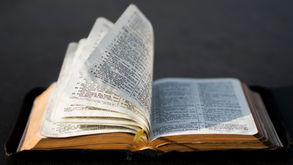From Word Order to World Order
- Uplifting Words

- Oct 26, 2019
- 7 min read
Updated: Nov 3, 2019
BY NADER SAIEDI

The Writings of Bahá’u’lláh cover a period of forty years, from His imprisonment in the Tehran dungeon in 1852 to His passing in 1892. In the following passage, He describes the purpose and the stages of His writings:
Behold and observe! This is the finger of might by which the heaven of vain imaginings was indeed cleft asunder. Incline thine ear and Hear! This is the call of My Pen which was raised among mystics, then divines, and then kings and rulers.
In the first part of this statement, Bahá’u’lláh presents the contrasting images of the finger of might and the heaven of vain imaginings. While the idea of cleaving the moon is attributed to the prophet Muhammad, now Bahá’u’lláh’s pen is rending not only the moon but the entire heaven, which represents the illusions, idle fancies, superstitions, and misconceptions that have erected walls of estrangement between human beings, have enslaved them, and have reduced their culture to the level of the animal. Bahá’u’lláh emphasizes that violence, oppression, and hatred are embodiments of vain imaginings and illusions constructed by human beings. Now, through his pen, He has come to tear away these veils, extinguish the fire of enmity and hatred, and bring people together.
In the second part of this statement, Bahá’u’lláh identifies the stages and order of His words, which were first addressed to mystics, then to divines, and finally to the kings and rulers of the world. His first writings, those written between 1852 and 1859, including the time He lived in Iraq, primarily address mystical concepts and categories. Those of the second stage, encompassing His writings between 1859 and 1867, address the religious leaders and their interpretation of religion. Finally His writings from 1868 on, directed both to the generality of humankind and to the kings and rulers of the world, address social and political questions. Each stage emphasizes a certain principle of Bahá’u’lláh’s worldview, following the sequence of His spiritual logic. The principles corresponding to these stages are as follows: a spiritual interpretation of reality, historical consciousness—even the historicity of the words of God—and global consciousness. The worldview of Bahá’u’lláh is defined by the mutual interdependence of these three principles.
Each stage of the writings of Bahá’u’lláh aims to reinterpret and reconstruct traditional ideas and worldviews. Therefore, the dynamics of His writings can be described by His reconstruction of mysticism, religion, and the social order.
1. Reconstruction of Mysticism
In His earlier writings, Bahá’u’lláh directly engages with Persian and Islamic forms of mysticism; through these and His later writings, He reconstructs mysticism so as to realize its full potential. To understand this point, it is useful to refer to the twin concepts of the arc of descent (qaws-i-nuzúl) and arc of ascent (qaws-i-ṣu‘úd) which comprise the spiritual or mystical journey. The arc of descent is normally perceived as the descent of reality from God—the dynamics of material creation, culminating in the emergence of human life. As a consequence, however, human beings are estranged from their origin and their own truth, which is the unity of God. This yearning for reunion, in turn, initiates the arc of ascent, the mystical journey of the soul’s return to its source. The arc of ascent, as seen, for example, in the Seven Valleys, transcends the realm of conflict and plurality to discover the underlying truth of all reality, namely God. With the annihilation of self that is found in this unity, one is assumed to have reached the zenith of the arc of ascent.
Although in traditional views of mystical consciousness, the zenith of the arc of ascent is the highest and end point of the spiritual journey, in reality this is just the beginning of a new stage. But in traditional consciousness all humans become sacred and equal only in God. In other words, only when living human beings, made of flesh and blood, are divested of their various determinations and turned into an abstraction do they become noble and sacred. For example, only when women are no longer women—that is, when their concrete determinations are negated and annulled in God—do they become equal to men. But concrete, living women remain inferior to men in rights, spiritual station, and rank. Thus despite the claim to see God in everything, the presence of social inequalities including slavery, patriarchy, religious discrimination, political despotism, and caste-like distinctions could go unchallenged.
For that reason, we need a further arc of descent to bring the fundamental insight and achievement of mystic oneness down to earth. In other words, after tracing the arc of ascent and attaining the consciousness of unity, one must be able to descend once again into the world of concrete plurality and time and maintain the consciousness of unity without being imprisoned in the consciousness of conflict and estrangement. In this way, the wayfarer is transformed into a new being who sees the unity of all in the concrete diversity of the world; in this arc of descent, one comes to see in all people their truth, or their divine attributes. The result of this consciousness is the end of the logic of separation, discrimination, prejudice, and hatred, and the beginning of the culture of the oneness of the human race, encompassing equal rights of all humans, the equality of men and women, religious tolerance and unity, and universal love for all people. Thus, according to Bahá’u’lláh, the real task of the mystic is not just the inward transformation of the annihilation of self in God but to transform the world so that the mystical truth of all human beings is manifested in the relations, structures, and institutions of social order. Since all beings become reflections of God, God and his unity are recognized within the diversity of moments and beings, resulting in the worldview of unity in diversity.
2. Reconstruction of Religion
The reconstruction of religion is, in fact, the first stage of the new arc of descent. In this first step, one descends from the unity of God and eternity to the diversity of the prophets and Manifestations of God. Here, history reveals a unity in diversity that reflects in its dynamics the unity of God: the Bahá’í view finds all the Manifestations of God to be one and the same, because they are reflections of divine unity and divine attributes. Since God is defined in the Torah, Gospel, and Qur’án as being the First and the Last, all the Manifestations are also the first and the last. They are also the return of each other. Bahá’u’lláh views the realm of religion as the reflection of both diversity (of historical progress) and unity (of all the prophets). He says:
It is clear and evident to thee that all the Prophets are the Temples of the Cause of God, Who have appeared clothed in divers attire. If thou wilt observe with discriminating eyes, thou wilt behold Them all abiding in the same tabernacle, soaring in the same heaven, seated upon the same throne, uttering the same speech, and proclaiming the same Faith. Such is the unity of those Essences of Being, those Luminaries of infinite and immeasurable splendor! Wherefore, should one of these Manifestations of Holiness proclaim saying: "I am the return of all the Prophets," He, verily, speaketh the truth. In like manner, in every subsequent Revelation, the return of the former Revelation is a fact, the truth of which is firmly established.
In other words, the Word of God, which is the essence of all religions, is a living and dynamic reality. It is one Word that, at different historical moments, appears in new forms. The different prophets are like the same sun that appears at different times at a different place on the horizon. While the traditional approach to religion usually reduces the identity of the sun to its historically specific horizon and therefore emphasizes opposition and hostility among various religions, Bahá’u’lláh identifies the truth of all religions as one and calls for the unity of religions. In Bahá’u’lláh’s view, a major cause of violence, war, and oppression in the world is religious fanaticism created by the vain imaginings of religious leaders. He warned: Religious fanaticism and hatred are a world-devouring fire whose violence none can quench. The Hand of Divine power can, alone, deliver mankind from this desolating affliction. The establishment of peace, then, requires overcoming such religious hatred and discord.
3. Reconstruction of the World
The second step of the new arc of descent relates to the wayfarer’s descent into the world. Here, the consciousness of unity necessarily leads to the principle of the oneness of humankind as well as to universal peace. In traditional religious consciousness, the relationship between the created and the Creator is repeated in all forms of social relations. Thus, the relation between men and women, kings and subjects, free persons and slaves, believers and non-believers, and even clerics and laymen repeat the relation between God and human beings. In this way, the illusion is created that domination, discrimination, violence, and opposition are legitimized by religion. In contrast, Bahá’u’lláh explains that the relation that truly obtains is that because all are created by God and are servants of God, all are equal. Instead of repeating in the realm of social order the relation of God to the created world, the servitude of all before God denotes the equality and nobility of all human beings. The task of true mysticism therefore is not to escape from the world, but rather to transform it so that it becomes a mirror of the republic of spirit or the kingdom of God. Bahá’u’lláh’s global consciousness and His concept of peace are embodiments of this reinterpretation of the world and social order, as reflected in the following statement in which He redefines what it is to be human:
That one indeed is a man who, today, dedicateth himself to the service of the entire human race. The Great Being saith: Blessed and happy is he that ariseth to promote the best interests of the peoples and kindreds of the earth. In another passage He hath proclaimed: It is not for him to pride himself who loveth his own country, but rather for him who loveth the whole world. The earth is but one country, and mankind its citizens.
The purpose of Bahá’u’lláh’s reinterpretation of mysticism, religion, and social order is to bring about a culture of unity in diversity and to institutionalize universal peace in the world. To discuss His specific concept of peace, it is necessary first to review the existing theories of peace in the social sciences and then identify the structure of Bahá’u’lláh’s vision.





















